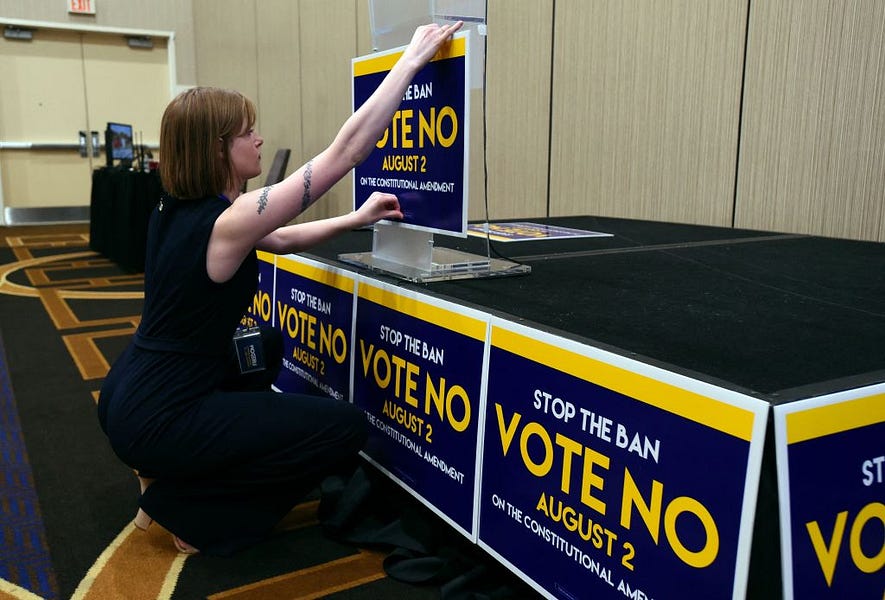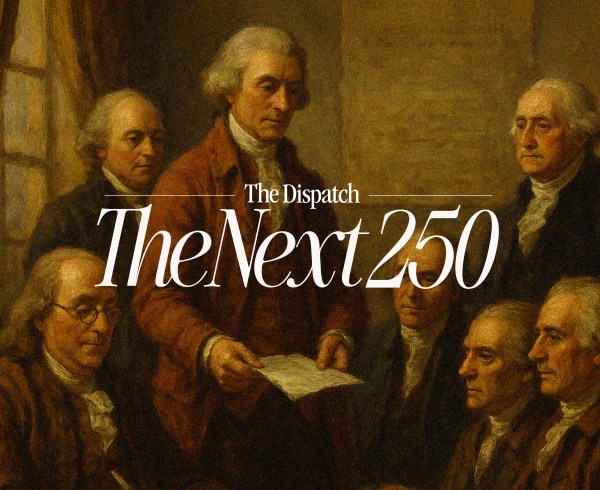KANSAS HINTS AT A CHANGED ELECTORATE
The big news from Kansas voters’ rejection this week of an amendment to the state’s constitution that would have allowed lawmakers to restrict abortion wasn’t that it failed, or even that it failed badly.
Kansas has a fraught history with abortion. Despite a great deal of focus on how conservative and “deep red” the Sunflower State is, Kansas has had among the most permissive abortion laws in the country and was the scene of the infamous 2009 murder of one of the only providers of late-term abortions in the state and the region. As the former king of Kansas politics, Bob Dole, showed in his own winding path on the issue, abortion has not been a simple issue in state politics.
Plus, the process was flawed. The amendment would have overturned a 2019 state Supreme Court ruling that held that the line “all men are possessed of equal and inalienable natural rights” in the Kansas Bill of Rights should be understood to include a right to unrestricted abortion. Rather than offering an alternative set of restrictions for voters to consider, the pro-lifers pushing the measure were asking for permission to add unspecified restrictions at a later date—a leap of faith in an era of low political trust. Ill-conceived, poorly executed, and offered at a time of intense anxieties on the subject, it was not surprising to see the measure win the support of just 41 percent of voters.
What surprised the heck out of me, though, was how many voters there were.
In 2018, which, like this year, was marked by high voter intensity nationally and with a competitive gubernatorial race in the state, 467,305 Kansans voted in primary elections. The count from Tuesday: 916,304 votes, with a handful still to be counted. It would be remarkable enough to see primary turnout almost double in four years, but that’s not even the most interesting part.
There were 270,578 more votes cast on the abortion measure than in both parties for the state’s red-hot gubernatorial race, and more than 191,667 votes on the amendment than there were cast in the state’s U.S. Senate race. There were more people who voted on the referendum but forwent the governor’s race than all of the votes that Democratic incumbent Gov. Laura Kelly received in her own lopsided primary win.
Part of this is the result of state primary laws. Kansas has a closed primary in which voters get a ballot of the party of their own registration—no party switching at the polling place. Independents can vote in either party’s primary, but have to join on the spot. It’s a low-cost move in terms of hassle, but carries social and emotional weight. Many, or maybe even even most, of the roughly 1 in 5 voters who weighed in on the abortion question but not the partisan primaries were independents who did not wish to affiliate with either party but still wanted to be heard.
That alone could tell us about the potency of the issue. There is a strong correlation between one’s likelihood of voting in a general election and voting in a primary election. If an issue is strong enough to get that many lower-propensity voters who reject both parties to actually show up for a primary on a sweltering Kansas August day, you have a real phenomenon on your hands.
You can bet that the correlation between primary voting and general election voting will substantially hold, and that most of those new primary voters will show up in November. Although they weren’t eligible to vote in the primary, you can bet that they will have a Democratic lean in the fall if this is such a motivating issue for them.
Let’s also assume, though, that some of the people who skipped the down-ballot races were party members who chose not choose, except for on the referendum and maybe just the Senate and gubernatorial contests. The participation gap between the top and bottom of the ticket in both parties certainly suggests as much. That points to a big shift as well. Those voters are likely to be ones who aren’t activists like the typical primary voter, but who came out because of this issue and only made it as far down the ballot as their interest and knowledge would allow.
Think of it this way: We were already on track to have another very high turnout election this year. Partisans are highly engaged and, as usual for the past 12 years, mad as hell. My expectation was for an election in which we again watched the two parties try to turn up the intensity with their own voters as much as possible in another bid to win a base vs. base election. But the Kansas result hints at the possibility of a surge in low-propensity voters.
As Republicans’ ongoing struggle in the generic ballot suggests, most of the effect of the abortion issue has been favorable for Democrats. But this will not be a straight line, and will not come with predictable outcomes in all cases. Certainly, the abortion debate will help Democrats in their effort to hold on to the Senate, where the correlation on the issue is the strongest. Senators are the ones who confirm Supreme Court justices. You can certainly see how there would be a similar effect on gubernatorial races, and maybe even on some statehouse contests. But in the battle for control of the House of Representatives, it will be harder for Democrats to make the connection.
The other thing Democrats should be wary about with these voters who are coming in because of abortion is that they may be left-of-center on this issue, but that doesn’t make them left of center on every issue. If these were committed progressives, they’d be registered and voting Democratic already anyway. There will be lots of pro-choice voters who will split their tickets to support access to abortion in one race, but for low taxes, more law enforcement, and, cleaning up public schools in others. These are less sorted voters who will surprise and frustrate both parties.
The message from Kansas is that the electorate has gotten bigger and less predictable than it was before the Dobbs decision. In a year that has been almost all bad news for Democrats prior to the summer, that’s a welcome change for the blue team. But both parties now have to remember that a lot of their assumptions about the nature of this race no longer apply.
Holy croakano! We welcome your feedback, so please email us with your tips, corrections, reactions, amplifications, etc. at STIREWALTISMS@THEDISPATCH.COM. If you’d like to be considered for publication, please include your real name and hometown. If you don’t want your comments to be made public, please specify.
STATSHOT
Biden job performance
Average approval: 37.8 percent
Average disapproval: 57.2 percent
Net score: -19.4 points
Change from one week ago: ↑ 4.4 points
Change from one month ago: ↓ 0.6 points
[Average includes: Ipsos/Reuters: 38% approve-57% disapprove; Monmouth University: 38% approve-56% disapprove; Gallup: 38% approve-59% disapprove; Suffolk University/USA Today: 39% approve-56% disapprove; American Research Group: 36% approve-58% disapprove]
Generic congressional ballot
Democrats: 43.8 percent
Republicans: 41.8 percent
Net advantage: Democratic Party +2.0 points
Change from one week ago: Republican Party ↓ 2.6 points
Change from one month ago: Republican Party ↓ 1.2 points
[Average includes: Ipsos/Reuters: 35% Democrat, 33% Republican; Monmouth University: 49% Democrat, 46% Republican; Suffolk University/USA Today: 44% Democrat, 40% Republican; Quinnipiac University: 45% Democrat, 44% Republican; SSRS/CNN: 46% Democrat, 46% Republican]
TIME OUT: ANOTHER FARM GOES UNDER WATER
Washington Post: “About 25 feet under the ocean surface, just off the coast of Noli, Italy, six plastic biospheres glow, part of an experiment with a novel type of aquaculture. The biospheres, tended by a group of scuba divers, are growing basil, strawberries, lettuce and other greens that are being farmed there for human consumption. Once harvested, the plants have been found to possess higher levels of essential oils and antioxidants—suggesting a potential use in pharmaceuticals—and a purer, more intense taste when eaten. … Inside the biospheres, the crops are reared in tightly controlled conditions. They grow without dirt, which means there are no parasites and no need for pesticides. And they are irrigated by the seawater that naturally evaporates and then condensates onto the interior walls of the dome. … These efforts feed into the larger dream…to make this technology accessible in areas where climate change, soil desertification and water scarcity have made food production increasingly difficult.”
GOP STATE LAWMAKERS DOUBLING USUAL PRIMARY LOSSES
Associated Press: “As Wisconsin’s longest-serving Assembly speaker, Republican Robin Vos has presided over efforts to restrict abortions, weaken unions, expand gun rights and push back against COVID-19 mandates. Despite that, he’s facing a primary challenger who claims he’s not conservative enough. The challenger’s argument: Vos should do more to respond to former President Donald Trump’s unfounded allegations of fraud in the 2020 election. Primary challengers like the one facing Vos next Tuesday have been successfully targeting incumbent state lawmakers across the country, and Republicans are taking the brunt of it. With more than half the state legislative primaries concluded, Republican incumbents this year have been losing at nearly twice the average rate of the past decade, according to data compiled for The Associated Press by the election tracking organization Ballotpedia. The primary loss rate for Democratic state lawmakers is similar to previous elections.”
Dems get their wish in Arizona, but electoral risks abound: Politico: “Even before Donald Trump, Arizona Republicans had a soft spot for hard-liners. … With Kari Lake poised to win the gubernatorial primary … there is no longer any traditionalist wing of the Republican Party in Arizona holding the line. … In … one of the most critical swing states in the country … the old Republican establishment has been replaced with election deniers from the top to the bottom of the statewide ticket. … Yet if Trump-y politics are difficult for the GOP in Arizona, that’s about all the state party has going now. … For Democrats, this was all good news. Instead of inflation or education [or] any of the other ‘traditional campaign issues that candidates normally discuss,’ [former state lawmaker and Republican consultant Stan Barnes] said, Democrats in Arizona this fall ‘get to talk about the Trump candidates. They get to talk about running against Donald Trump.’”
Blue Dogs near extinction: Roll Call: “Squeezed by an increasingly progressive party base, redistricting and a difficult election cycle, the moderate wing of the Democratic Party in the House could fall to its smallest number since its inception in the mid-1990s. The fiscally conservative, pro-national security caucus within the Democratic Party boasted 54 members after the 2008 elections. Depending how some key races break this November, there could be as few as eight Blue Dogs in the next Congress. … But even in a new Republican majority, a small group of Blue Dogs could be influential. If a new GOP speaker of the House experiences too many defections on their right flank, Blue Dogs may be necessary to get key legislation through the House, including any bills preferred by Biden in what could be the final years of his administration.”
Latino GOP candidates key to flipping the House: Politico: “House Republicans could be on track to increase their number of Latino members in 2023 by 50 percent—or more—after concerted recruitment efforts and a slew of summer primary wins by Hispanic and Latino candidates from Oregon to Texas to Virginia. … Now, the party has landed Hispanic nominees in more than a half dozen battleground districts—and another three are well positioned to win their primaries over the next month. It’s a diversity push that takes on added significance because the GOP has recently begun aggressively courting Latino voters since Trump’s surprising surge in heavily Hispanic areas of the country in 2020. … “We’re offering candidates that actually not only look and sound like the district but are focused on the issues that matter most to them,” said Rep. Tom Emmer, the chair of the House GOP campaign arm.
Jackie Walorski, R.I.P.: Time: “Rep. Jackie Walorski’s role at the Capitol was easy to miss if you weren’t looking. The Indiana Republican wasn’t the type that elbowed her way to the front of a photo op or solicited invitations to insider events. When she had an issue with someone or something, she was civil but direct—never one to trade in the Capitol’s most dangerous currency, gossip and innuendo. … Walorski’s background read like an idealized “About Me” page for a Republican candidate, with time spent studying at Jerry Falwell’s Liberty University and four years as a missionary in Romania. In the House, she was a good barometer for what Christian conservatives could stomach in compromises and where the red lines were. … Most importantly, she never lost sight of treating her fellow humans with respect, even when she thought they were unrepentantly wrong.”
BRIEFLY
‘How the Claremont Institute Became a Nerve Center of the American Right’—NYT
Democrats hang hopes on falling gas prices —Politico
Hawley, thirsty for ‘24, stands alone against Finland and Sweden’s NATO entry—The Hill
Labash: ‘Is the Alex Jones joke over? Or is it still on the rest of us?’—Slack Tide
WITHIN EARSHOT: FROM ONE SWAMP TO ANOTHER
“Looks to me like we got rinky-doo’d. That’s a Louisiana word for ‘screwed.’ And we got our ass kicked. That’s the way my people back home see it.”— Sen. John Kennedy on Sen. Joe Manchin’s reconciliation deal with Democratic leader Chuck Schumer.
MAILBAG
A minor comment in response to your response to Laura Walhood [a new atheist who wrote in for the July 22 note with concerns about “the religious people who are creating frightening new values with a religious imprimatur.”]: Religious institutions are also centers of community, where you can simply meet other people in this increasingly lonely online world, where you might already happen to have something in common. I have never believed in a deity and can’t imagine what would cause that to change, but I semi-regularly attend religious services, and try to get involved in activities at my synagogue, primarily as a way to meet and connect with other people. It’s hard and awkward to make new friends in midlifemid-life, and virtually all of the friends I have made since college I met at the synagogues I have been a member of. It’s also an opportunity to volunteer, which I don’t do enough of even though it seems to put me in a better mood than I had ever expected. Whether you meet other people at a religious institution, or a softball team, poker game, gardening club, or some other secular organization that you encountered on meetup.com, it provides a sense of community. If you aren’t meeting people in person, some online alternatives that enable people to shield their identities are less than constructive. And for whatever human-nature reason, having to interact with people physically in person seems to cause people to be better-mannered than meeting online.” —Doug Bergman, West Jordan, Utah
I like it, Mr. Bergman! I have found Judaism, especially of the Reform variety, to be a safe space for the theistically skeptical. In Christianity, it goes the other direction. Reform Christians like me focus more on the centrality of faith rather than the emphasis on “works” among Roman Catholics and some Protestant sects. Your advice is excellent, though, regardless of whether one is a believer or not. Being in community and, most importantly, serving others are not just things I am called to do as a Christian, but are vital to my happiness and well-being. It works even if you don’t believe in the supernatural component. Gathering together for mutual care and service— to love each other—is, like the song says, what the world needs now. Or, as my old daddy used to say about going to church when we would rather have slept in or played golf on a Sunday morning: “Bring your a**, and your heart will follow.”
“I was actually excited last week at the prospect of learning how to say croakano only to have my hopes dashed and heart crushed with a tiny snippet. Please, please provide the full pronunciation a la Merriam-Webster. Many thanks.” —Denise Cote, Old Saybrook, Connecticut
Holy croakano, indeed, Ms. Cote! You live so close to the Poconos—less than a three-hour drive. Surely that had to help if the phonetic spelling did not. (If you’re unfamiliar with the modern lore of the Poconos, please read the amazing story of the life of Morris Wilkins, inventor of the heart-shaped bathtub.) And if you want to hear the pronunciation aloud, paste the phonetic spelling, , ˈkroʊkəno, into this International Phonetic Alphabet reader.
You should email us! Write to STIREWALTISMS@THEDISPATCH.COM with your tips, kudos, criticisms, insights, rediscovered words, wonderful names, recipes and, always, good jokes. Please include your real name—at least first and last—and hometown. Make sure to let me know in the email if you want to keep your submission private. My colleague, the intrepid Nate Moore, and I will look for your emails and then share the most interesting ones and my responses here. Clickety clack!
CUTLINE CONTEST: SLIDING INTO YOUR MENTIONS LIKE…

The winner of this week’s cutline contest had the best take among the multiple entrants who saw the 45th president doing that ubiquitous wedding DJ favorite, 2000’s “Cha Cha Slide.” Our winner, though, captured the subject’s voice best of all:
“It’s right foot, left stomp, left foot, left stomp, then cha-cha real smooth. And believe me, no one cha-chas smoother than me.” —Joel Stewart, Edmond, Oklahoma
Honorable mentions:
“I kept a key to the White House just in case. Guess which hand it’s in?” —Rob Fisher, Azusa, California
“Touch my hair and you will answer to Giuliani.”—Leo Algminas, Wilmette, Illinois
Winner, Frank Loesser Superfan Division:
“Rip, rip, rip the Chipmunks from the field!”—Richard Kennedy, Ferndale, Michigan
Winner, Gen X Nostalgia Division:
“The 2024 Edition of ‘Mike Tyson’s Punch-Out’ has a new Bald Bull.” —Tripp Whitbeck, Arlington, Virginia
Send your proposed cutline for the picture that appears at the top of this newsletter to STIREWALTISMS@THEDISPATCH.COM. We will pick the top entrants and an appropriate reward for the best of this month—even beyond the glory and adulation that will surely follow. Be hilarious, don’t be too dirty, and never be cruel. Include your full name and hometown. Have fun!
A BURNING FEAR
Cowboy State Daily: “The spokesman for Medicine Bow National Forest is warning visitors to avoid lighting spiders on fire, at least outside of a fire ring, or else they could cause a wildfire like a Utah man did this week. ‘That’s a first, I’ve never heard of that one,’ forest spokesman Aaron Voos told Cowboy State Daily on Wednesday. ‘You should definitely not try and burn spiders. We can all learn from that.’ On Monday, a Utah man saw a spider while hiking in Springville, Utah, according to the Deseret News. For an unknown reason, he attempted to light the spider on fire and sparked a 60-acre wildfire. … Voos said the only way burning a spider would have been (technically) OK is if the arachnid had been inside of a fire ring, which is established to keep campfires from spreading.”
Chris Stirewalt is a contributing editor at The Dispatch, a senior fellow at the American Enterprise Institute and the author of Broken News, a new book on media and politics. Abbey Black and Nate Moore contributed to this report.







Please note that we at The Dispatch hold ourselves, our work, and our commenters to a higher standard than other places on the internet. We welcome comments that foster genuine debate or discussion—including comments critical of us or our work—but responses that include ad hominem attacks on fellow Dispatch members or are intended to stoke fear and anger may be moderated.
With your membership, you only have the ability to comment on The Morning Dispatch articles. Consider upgrading to join the conversation everywhere.